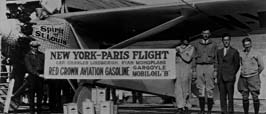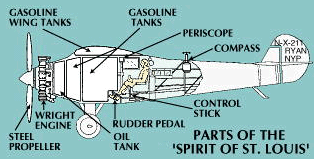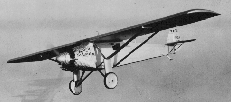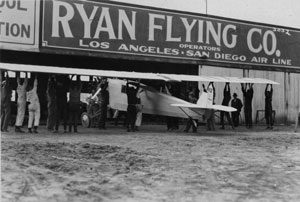
The Spirit of St. Louis
The Spirit of St. Louis is a wonderful plane. It’s like a living creature, gliding along smoothly, happily, as though a successful flight means as much to it as to me, as though we shared our experiences together, each feeling beauty, life, and death as keenly, each dependent on the other’s loyalty. We have made this flight across the ocean, not I or it. Spirit of St. Louis name
Download technical preparation of the airplane - Spirit of St. Louis- PDF File
Given here is a brief history of the design and construction of the - Spirit of St. Louis, the airplane that Charles Lindbergh flew solo across the Atlantic. Although the plan was to modify a standard model Ryan M-2, it was quickly determined that modification was less practical than redesign. Colonel Lindbergh's active participation in the design of the aircraft is noted. Given here are the general dimensions, specifications, weight characteristics, and man hours required to build the aircraft.
Paris to New York or New York to Paris Why shouldn't I fly from New York to Paris?
As a youth, Lindbergh studied with fascination the World War I flying exploits of French ace Rene Fonck who had shot down 75 German planes in the war. In September 1926, Fonck set his sights on crossing the Atlantic from New York to Paris and claiming Orteig's bounty. It was not to be. Fonck's plane, a silver biplane with a luxurious cabin, burst into flames before it even left the ground. Fonck survived the crash, but two crew members were killed. In 1926 Charles Lindbergh had not yet achieved the level of acclaim of his more illustrious flying counterparts. He had, however, gained a reputation as a talented flyer. His experience as a daredevil barnstormer, expert mechanic, and intrepid airmail pilot made many within the relatively small community of flyers take notice. As important, Lindbergh was full of the confidence necessary to undertake such a bold adventure. "Why shouldn't I fly from New York to Paris? ...I have more than four years of aviation behind me, and close to two thousand hours in the air. I've barnstormed over half of the forty-eight states. ...Why am I not qualified for such a flight?" he later wrote in his autobiographical book, "The Spirit of St. Louis." Lindbergh convinced himself that he was qualified for such a flight, and set his sights upon convincing others.
A budget of $15,000
Lindbergh's reputation as an ace pilot was unassailable in St. Louis. He had pioneered the airmail routes between that city and Chicago. Harry Knight, president of the St. Louis Flying Club, had great respect for Lindbergh. So much so that Knight chose Lindbergh as his personal flight instructor. Lindbergh, in turn, came to Knight when seeking backers for his proposed flight. Knight put Lindbergh in contact with the head of the St. Louis Chamber of Commerce, Harold Bixby. Meeting with Bixby, Lindbergh predicted great things for St. Louis if the city were to put its support behind such an historic flight. Painting a picture of St. Louis as an aviation hub, Lindbergh convinced Bixby to sponsor his flight. A budget of $15,000 was agreed upon.
A single-engine plane
With his backers entrusting in him their full confidence, Lindbergh set off to find the right plane. His notion of what constituted the right plane for such a flight put him at odds with the prevailing ideas of the day. While other aviators were placing their faith in the increased power and purported safety of multi-engine planes, Lindbergh determined that multiple engines increased, rather than decreased, the odds of failure. "I'm not sure three engines would really add much to safety on a flight like that. There'd be three times the chance of engine failure," he later recorded. For his transatlantic attempt, he sought out a single-engine plane. And he would be flying alone. His equation was simple: less weight (one engine, one pilot) would increase fuel efficiency and allow for a longer flying range. After failing to convince several airplane manufacturers of the rightness of his thinking, Lindbergh was told of a single-engine plane owned by the Columbia Aircraft Corporation of New York that could be his for $15,000. That sum excluded an engine. Still, Lindbergh wanted the plane. He walked away from the deal, however, when Columbia Aircraft Corporation president Charles Levine insisted on choosing the pilot and crew. Nineteen-twenty-six had turned into 1927, and Lindbergh was running out of time. Other aviators were progressing with tests and flight plans, and Lindbergh still didn't even have a plane.
Ryan Airlines Corporation
In February, 1927, Lindbergh's luck improved. Less than 24 hours after hearing of Lindbergh's search for a single-engine plane, the Ryan Airlines Corporation of San Diego, California offered to build such a plane for $6,000. Again, excluding the engine. Ryan, led by company president Frank Mahoney, would need three months to manufacturer Lindbergh's "Spirit of St. Louis." Upon arriving at the Ryan headquarters to meet with Mahoney and chief engineer and designer Donald Hall, Lindbergh was unimpressed with what he saw. Ryan Airlines was housed in a broken down building that used to be a fish cannery. A discouraging stench filled the air. After meeting with Mahoney and Hall, however, Lindbergh's spirits were much improved. The men voiced full confidence in Lindbergh's choice of a single-engine plane and Lindbergh was won over by their apparent skill and dedication, even after he informed them that the plane would have to be completed in two months, not three. From that moment on, Donald Hall practically lived at Ryan Airlines. His commitment was matched by that of his staff, as voluntary overtime became the norm. These men sensed they were becoming part of something historic.
Designed with one thought
Completion on April 28, 1927
Upon its completion on April 28, 1927, the "Spirit of St. Louis" weighed in at 2,150 lbs. when empty. It stood 9 feet, 8 inches high, was 27 feet, 8 inches long, and had a 46-foot wingspan. The plane was powered by a 220-horsepower, air-cooled, 9-cylinder Wright J-5C "Whirlwind" engine that was estimated to be able to perform flawlessly for over 9,000 hours. The engine was outfitted with a special mechanism designed to keep it greased during the entire transatlantic flight.
May 1927
Smithsonian National Air and Space Museum
Today, Lindbergh's "Spirit of St. Louis" is housed in the Smithsonian National Air and Space Museum in Washington, D.C. It is one of the museum's most popular attractions.
Design Features:
Eemergency Equipment Carried in the Spirit of St. Louis
The following emergency equipment was carried in the the Spirit of St. Louis on the flights between San Diego and Paris.
Ryan Airlines Co- San Diegans who built the original "Spirit of St. Louis":
Builders of the original "Spirit of St. Louis" pose before the plane prior to Lindbergh's departure from San Diego in 1927: (left to right)
Other "Spirit of St. Louis" builders not shown in photo:
Technical preparation of the Airplane "Spirit of St. Louis" Written for the National Avisory Committee for Aeronautice" By Donald A. Hall Chief, Engineer, Ryan Airlines, Inc. July 1927
Given here is a brief history of the design and construction of the—Spirit of St. Louis, the airplane that Charles Lindbergh flew solo across the Atlantic. Although the plan was to modify a standard model Ryan M-2, it was quickly determined that modification was less practical than redesign. Colonel Lindbergh's active participation in the design of the aircraft is noted. Given here are the general dimensions, specifications, weight characteristics, and man hours required to build the aircraft.
View individual pages or download PDF of the technical preparation of the airplane—Spirit of St. Louis:
Click on the thumbnail images below to see the full-size image of individual pages or download all pages in a PDF file format. Adobe Acrobat Reader must be installed.
Source: National Advisory Committee for Aeronautics
The sites of the construction and final asembly of "Spirit of St Louis"
A Scott Berg in 'Lindbergh' (1998) adds: The landing gear was reassembled, and the fuselage was hoisted up by its tail and attached to the back of Claude Ryan's 1925 Studebaker roadster, then towed tail-first to Dutch Flats, the Ryan test field on the edge of the city.
Both books contain (different) photographs of the wing on top of the empty boxcar.
- Charles Lindbergh, 1927
 "Spirit of St. Louis" was named in honor of Lindbergh's supporters in St. Louis, Missouri, who paid for the aircraft. "NYP" is an acronym for "New York-Paris," the object of the flight.
"Spirit of St. Louis" was named in honor of Lindbergh's supporters in St. Louis, Missouri, who paid for the aircraft. "NYP" is an acronym for "New York-Paris," the object of the flight.
 PDF Download includes general dimensions, specifications, weight characteristics, and man hours required to build the aircraft. (Donald A. Hall
NACA TN 257
Jul 1927
) Download Now
PDF Download includes general dimensions, specifications, weight characteristics, and man hours required to build the aircraft. (Donald A. Hall
NACA TN 257
Jul 1927
) Download Now
 In 1919 Raymond Orteig, a Frenchman who owned the Brevoort and Lafayette hotels in New York City, made the fledgling flying world an extraordinary offer. Enthralled by tales of pioneer aviators, Orteig put up a purse of $25,000 to the first aviator to fly nonstop from Paris to New York or New York to Paris. Orteig said his offer would be good for five years. Five years came and went. No one accomplished the feat. No one even tried. In 1926, Orteig extended the term of his offer another five years. This time around aviation technology had advanced to a point where some thought it might actually be possible to fly across the vast Atlantic. Charles A. Lindbergh was one of them.
In 1919 Raymond Orteig, a Frenchman who owned the Brevoort and Lafayette hotels in New York City, made the fledgling flying world an extraordinary offer. Enthralled by tales of pioneer aviators, Orteig put up a purse of $25,000 to the first aviator to fly nonstop from Paris to New York or New York to Paris. Orteig said his offer would be good for five years. Five years came and went. No one accomplished the feat. No one even tried. In 1926, Orteig extended the term of his offer another five years. This time around aviation technology had advanced to a point where some thought it might actually be possible to fly across the vast Atlantic. Charles A. Lindbergh was one of them.



 "The Spirit of St. Louis" was designed with one thought in mind: to get to Paris. Extra fuels tanks were added and the wing span increased to accommodate the additional weight. The plane would have a maximum range of 4,000 miles, more than enough to reach Paris. One of the more innovative design decisions involved placing the main fuel tank in front of, rather than behind, the pilot's seat. Lindbergh didn't want to be caught between the tank and the engine if the plane was forced to land. This configuration also meant that Lindbergh would not be able to see directly ahead as he flew. It didn't seem to trouble him much. "There's not much need to see ahead in normal flight," Lindbergh told Donald Hall. "I won't be following any airways. When I'm near a flying field, I can watch the sky ahead by making shallow banks. All I need is a window on each side to see through..." If needed, Lindbergh would use a periscope attached to the plane's left side to see what was in front of him.
In his efforts to pare down the plane's weight, Lindbergh considered every detail. Any item considered too heavy or unnecessary was left behind. These included a radio, parachute, gas gauges, and navigation lights. Lindbergh designed for himself special lightweight boots for the flight, and went so far as to cut his maps down to include only those reference points he would need. Every ounce mattered. Instead of a heavy leather pilot's seat, Lindbergh would be perched in a far lighter wicker chair.
"The Spirit of St. Louis" was designed with one thought in mind: to get to Paris. Extra fuels tanks were added and the wing span increased to accommodate the additional weight. The plane would have a maximum range of 4,000 miles, more than enough to reach Paris. One of the more innovative design decisions involved placing the main fuel tank in front of, rather than behind, the pilot's seat. Lindbergh didn't want to be caught between the tank and the engine if the plane was forced to land. This configuration also meant that Lindbergh would not be able to see directly ahead as he flew. It didn't seem to trouble him much. "There's not much need to see ahead in normal flight," Lindbergh told Donald Hall. "I won't be following any airways. When I'm near a flying field, I can watch the sky ahead by making shallow banks. All I need is a window on each side to see through..." If needed, Lindbergh would use a periscope attached to the plane's left side to see what was in front of him.
In his efforts to pare down the plane's weight, Lindbergh considered every detail. Any item considered too heavy or unnecessary was left behind. These included a radio, parachute, gas gauges, and navigation lights. Lindbergh designed for himself special lightweight boots for the flight, and went so far as to cut his maps down to include only those reference points he would need. Every ounce mattered. Instead of a heavy leather pilot's seat, Lindbergh would be perched in a far lighter wicker chair.
 Two days before Lindbergh's scheduled May 10, 1927 departure from San Diego, news broke that Frenchmen Charles Nungesser and Francois Coli had taken off from Paris bound for New York. It appeared as if all of Lindbergh's and Ryan Airlines' efforts had been in vain. However, despite a radio report claiming that Nungesser and Coli had been spotted over the Atlantic, the two were never seen again. Lindbergh's chance for glory was still within reach. "Lucky Lindy" and his "Spirit of St. Louis" landed at Curtiss Field on Long Island, New York, on May 12, 1927. En route, pilot and plane had already broken the existing record for the fastest transcontinental flight. Eight days later, Lindbergh and his silver plane were poised to set new records as they took off from Roosevelt Field. Fighting fog, icing, and sleep deprivation, Lindbergh landed safely at Le Bourget Field in Paris at 10:22pm on May 20, 1927. "The Spirit of St. Louis" had carried him over 3,600 miles in 33.5 hours. A new aviation hero was born, and the "Spirit of St. Louis" attained legendary status.
Two days before Lindbergh's scheduled May 10, 1927 departure from San Diego, news broke that Frenchmen Charles Nungesser and Francois Coli had taken off from Paris bound for New York. It appeared as if all of Lindbergh's and Ryan Airlines' efforts had been in vain. However, despite a radio report claiming that Nungesser and Coli had been spotted over the Atlantic, the two were never seen again. Lindbergh's chance for glory was still within reach. "Lucky Lindy" and his "Spirit of St. Louis" landed at Curtiss Field on Long Island, New York, on May 12, 1927. En route, pilot and plane had already broken the existing record for the fastest transcontinental flight. Eight days later, Lindbergh and his silver plane were poised to set new records as they took off from Roosevelt Field. Fighting fog, icing, and sleep deprivation, Lindbergh landed safely at Le Bourget Field in Paris at 10:22pm on May 20, 1927. "The Spirit of St. Louis" had carried him over 3,600 miles in 33.5 hours. A new aviation hero was born, and the "Spirit of St. Louis" attained legendary status.
 The "Spirit of St. Louis" was designed by Donald Hall under the direct supervision of Charles Lindbergh. It is a highly modified version of a conventional Ryan M-2 strut-braced monoplane, powered by a reliable Wright J-5C engine. Because the fuel tanks were located ahead of the cockpit for safety in case of an accident, Lindbergh could not see directly ahead, except by using a periscope on the left side or by turning the airplane and looking out a side window. The two tubes beneath the fuselage are flare dispensers that were installed for Lindbergh's flights to Latin America and the Caribbean.
The "Spirit of St. Louis" was designed by Donald Hall under the direct supervision of Charles Lindbergh. It is a highly modified version of a conventional Ryan M-2 strut-braced monoplane, powered by a reliable Wright J-5C engine. Because the fuel tanks were located ahead of the cockpit for safety in case of an accident, Lindbergh could not see directly ahead, except by using a periscope on the left side or by turning the airplane and looking out a side window. The two tubes beneath the fuselage are flare dispensers that were installed for Lindbergh's flights to Latin America and the Caribbean.
* Source: Lindbergh, Charles A. "The Spirit of St. Louis"

Gordy L. Boyd, George F. Hammond, Burt Tindale, Jesse Cooper, O.R. McNeel, Walter O. Locke, Charles A. Lindbergh, Georgia Mathias Borthwick, Lawrence W. Muehleisen, Frank Say, Ed "K" Crosby, June Eddy, A.J. Edwards, Daniel B. Burnett, Jr., Peggy DeWitt, Fred H. Rohr, Ruth Kennaugh Clemens, Mrs. L. Bray, Shirley Morrison, Bill Van den Akker, Mel (Andy) Anderson, Pat Davenport, Ed Terry, C. Randolph, Elmer Dye, C. Rand, Gus Eoff, Walt A. Crawford, Unknown, Doug Corrigan, John Van der Linde, Dale Powers, J.J. Red Harrigan, William Hawley Bowlus and Frank Mahoney.
Donald Hall, Henry Hunold, Ed Sherburn, Ed Morrow, Ed Krauscyk, B. Jones, Fred Magula, Fred Ayres, Doug Kelley, William Bodie, Lon Wheeler, John Lester, John Stoner, Jimmy Erickson, Albert C. Crygier, Helen Thorpe, Charlie Miller and Charlie Hansen.


0001
76403 bytes
1020 x 1218

0002
114881 bytes
1020 x 1218

0003
115286 bytes
1020 x 1215

0004
118119 bytes
1020 x 1215

0005
113656 bytes
1020 x 1209

0006
87305 bytes
1020 x 1209

0007
113013 bytes
1020 x 1218

0008
78208 bytes
1020 x 1215

0009
77094 bytes
1020 x 1218

0010
74433 bytes
1020 x 1218
Lindbergh describes the sites of the construction and
final asembly of 'Spirit of St Louis' in his book, "The Spitit of St Louis"' (1953) as follows: The Ryan Airlines factory is an old dilapidated building near the waterfront...........There's no flying field, no hanger, no sound of engines warming up; and the unmistakable smell of dead fish from a near-by cannery mixes with the banana odor of dope from drying wings. and This morning we hauled the Spirit of St. Louis to Dutch Flats. By taking off the landing gear on one side, it was easy enough to move the fuselage through the big doorway of the factory's ground floor but the wing in the loft created an unexpected problem.............no one thought about getting a forty-six-foot wing out of the room where it was built. For a while it looked as though we'd have to tear out a section of the wall; but careful measurement showed that we could get by if we tipped the wing over at an angle and removed the loft's double doors.............Fortunately an empty boxcar was standing on the railroad siding next to the factory and all hands turned out to push the boxcar into a position which would form the first step downward from the loft. Then, with a contractor's derrick, we maneuvered the wing onto the car top, and from the car top down to a waiting truck.

Dutch Flats Sign
San Diego, CA
Picture & description by Geoffrey Batten
Privacy Policy | Terms and Conditions | This site is not affiliated with the Lindbergh family,
Lindbergh Foundation, or any other organization or group.
This site owned and operated by the Spirit of St. Louis 2 Project.
Email: webmaster@charleslindbergh.com
® Copyright 2014 CharlesLindbergh.com®, All rights reserved.
Help support this site, order your www.Amazon.com materials through this link.

